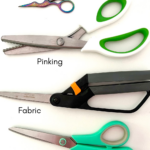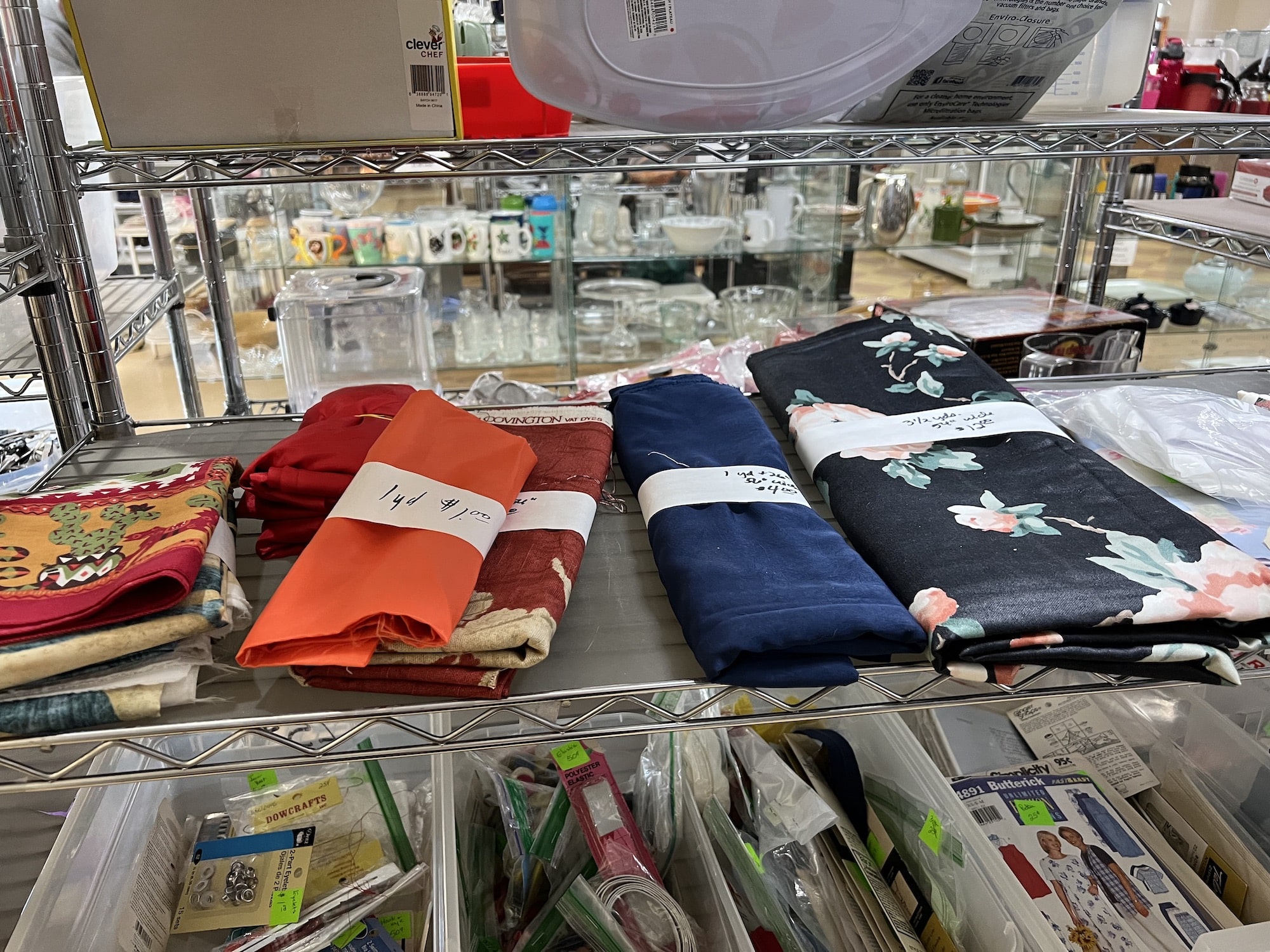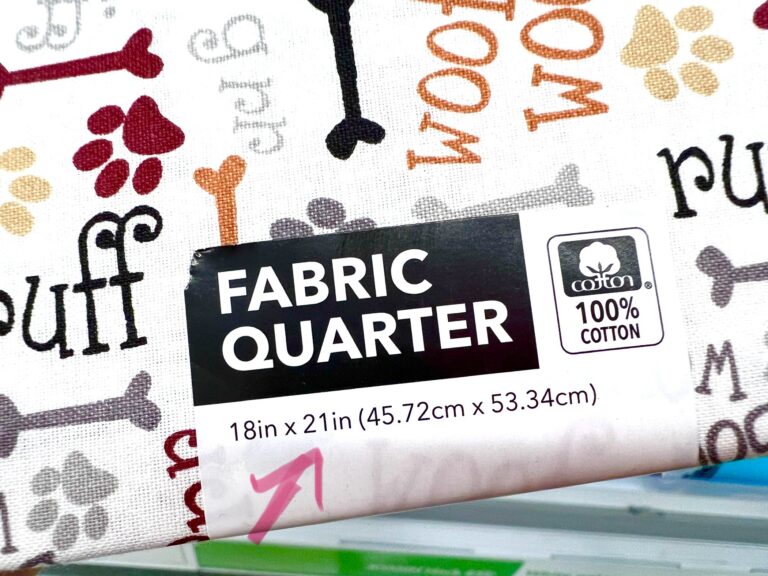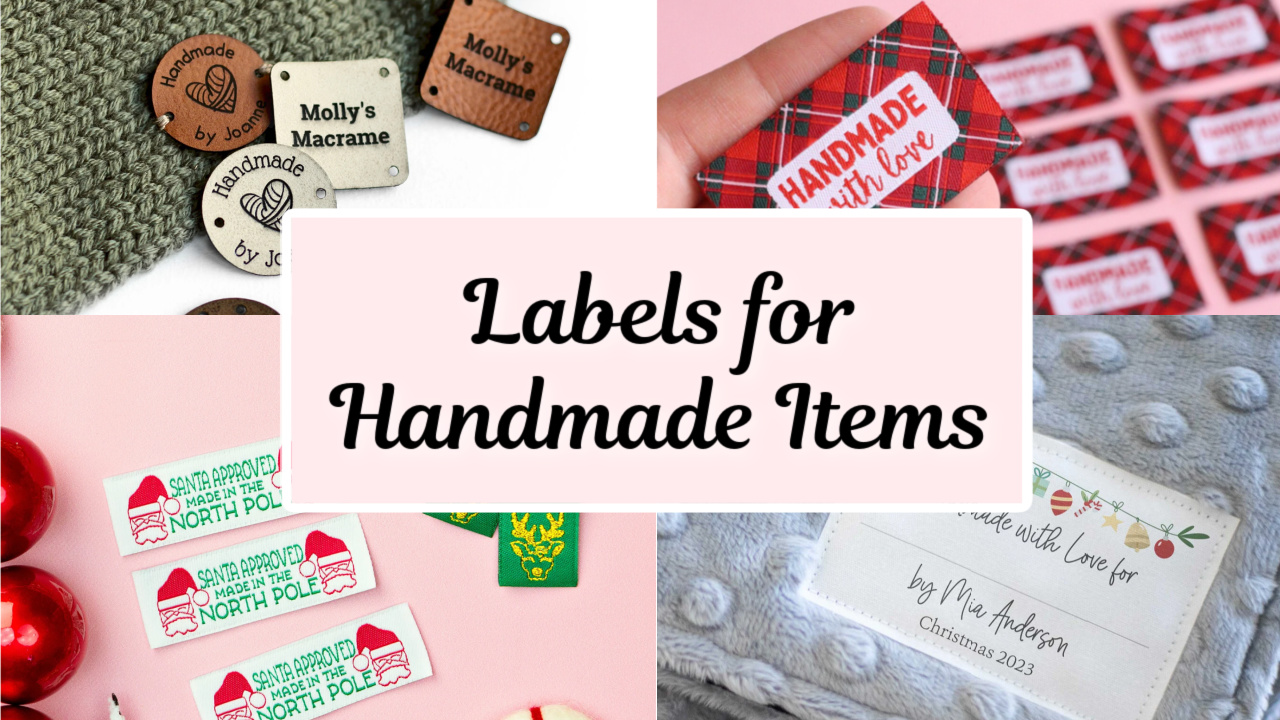Essential Guide to Different Types of Sewing Scissors
If you are overwhelmed by the different types of sewing scissors, you are not alone! There are so many different scissors used in sewing that you may feel like you need to own them all, but you don’t!
In our Ultimate Guide to the Best Scissors for Sewing, we will explain what the unique types of scissors are and the best choice for your needs.
In this list of the best sewing scissors, we break down the most important tools, as well as the nice-to-haves so you don’t spend more money than needed to set up your sewing kit.
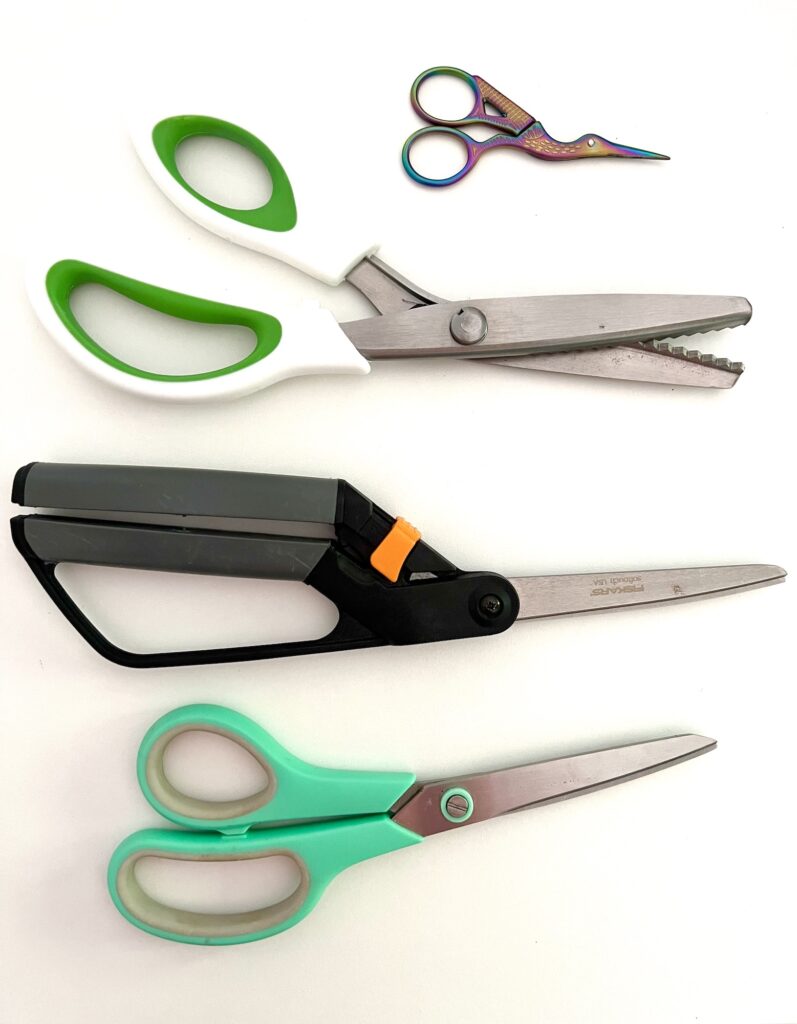
These are the pair of sewing scissors we will discuss, as well as their specific use:
- Fabric Scissors
- Left-Handed Fabric Scissors
- General All-Purpose Scissors
- Dressmaker Shears
- Pinking Shears
- Rotary Cutter
- Thread Snips
- Embroidery Scissors
- Tailor Shears
- Appliqué Scissors
- Folding Scissors
- Electronic Shears
- Scissors vs. Shears
- Best Scissor Brands
- How to Care For and Sharpen Your Scissors
Be sure to also see our Guide to Scissors for Cutting Felt.
Scissor Rules
- Never use your sewing scissors on anything other than fabric, felt or thread! If you use them to cut paper or patterns you could dull the sharp blades. Even using fabric scissors on paper products every once in a while can really dull the scissors, which means you will need to buy new ones or sharpen them more frequently.
- Only use the right kind of scissors for the right kind of project. Don’t use embroidery scissors to cut patterns out. Don’t use fabric scissors to cut out patterns.
- Be careful with how you store your sewing scissors because they are so sharp! You do not want to reach into your sewing basket and get cut or stabbed with the sharp scissors!
Fabric Scissors
Perhaps the most important pair of scissors you can own is general fabric scissors! You will be using them to cut out the fabric or felt that you will use for all of your sewing projects, so be sure to get a good pair of scissors.
These pairs of scissors usually have a bent handle, but not always.
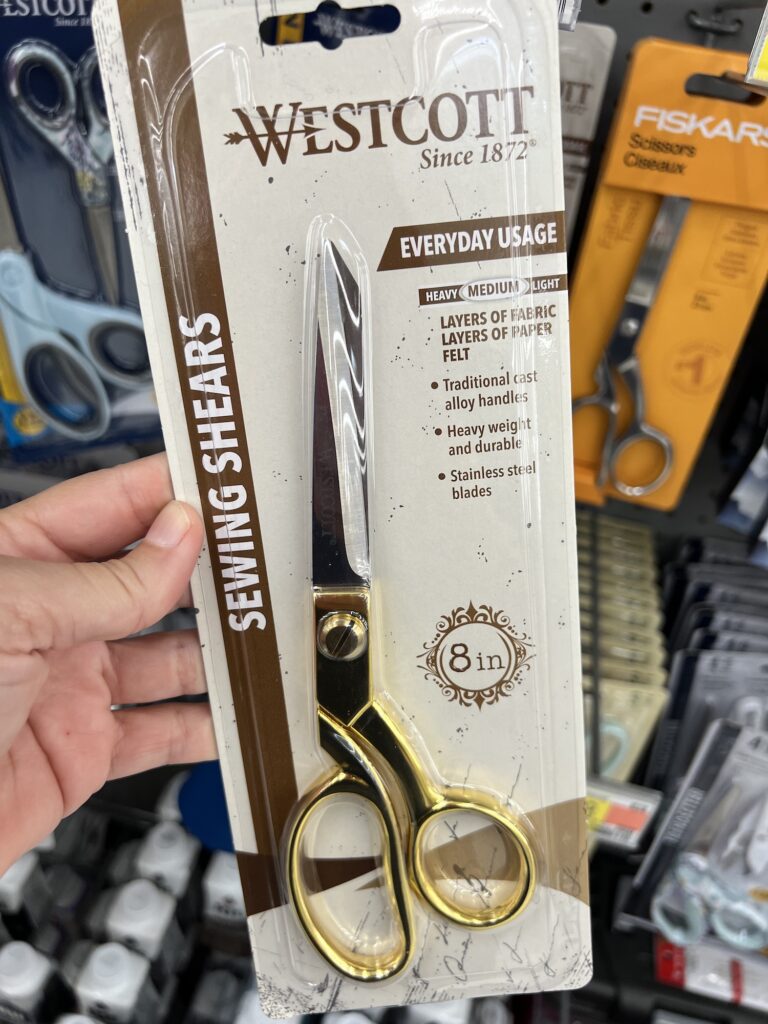
If you sew a lot (and in different rooms of the house) you may find yourself losing your scissors a LOT! So maybe invest in two pairs to save your sanity!
Never use paper scissors to cut your fabric. You know, that regular scissors you have in your junk drawer or office. These scissors would be fine for cutting out paper patterns, but they won’t cut through fabric easily and they could create rough edges.
Investing in a pair of high quality scissors with stainless steel blades can be a smart decision, as they are likely to last you a lifetime. They won’t rust and they can be sharpened.
While all modern blades are almost always stainless steel, many handles are not. If you want a true buy-it-for-life pair of scissors, get ones with stainless steel handles, too.
However, comfort is also important, because these are going to be one of the most essential tools you have. Soft-grip handles can really make a difference in hand fatigue.
I personally prefer using soft grip handles rather than stainless steel ones.
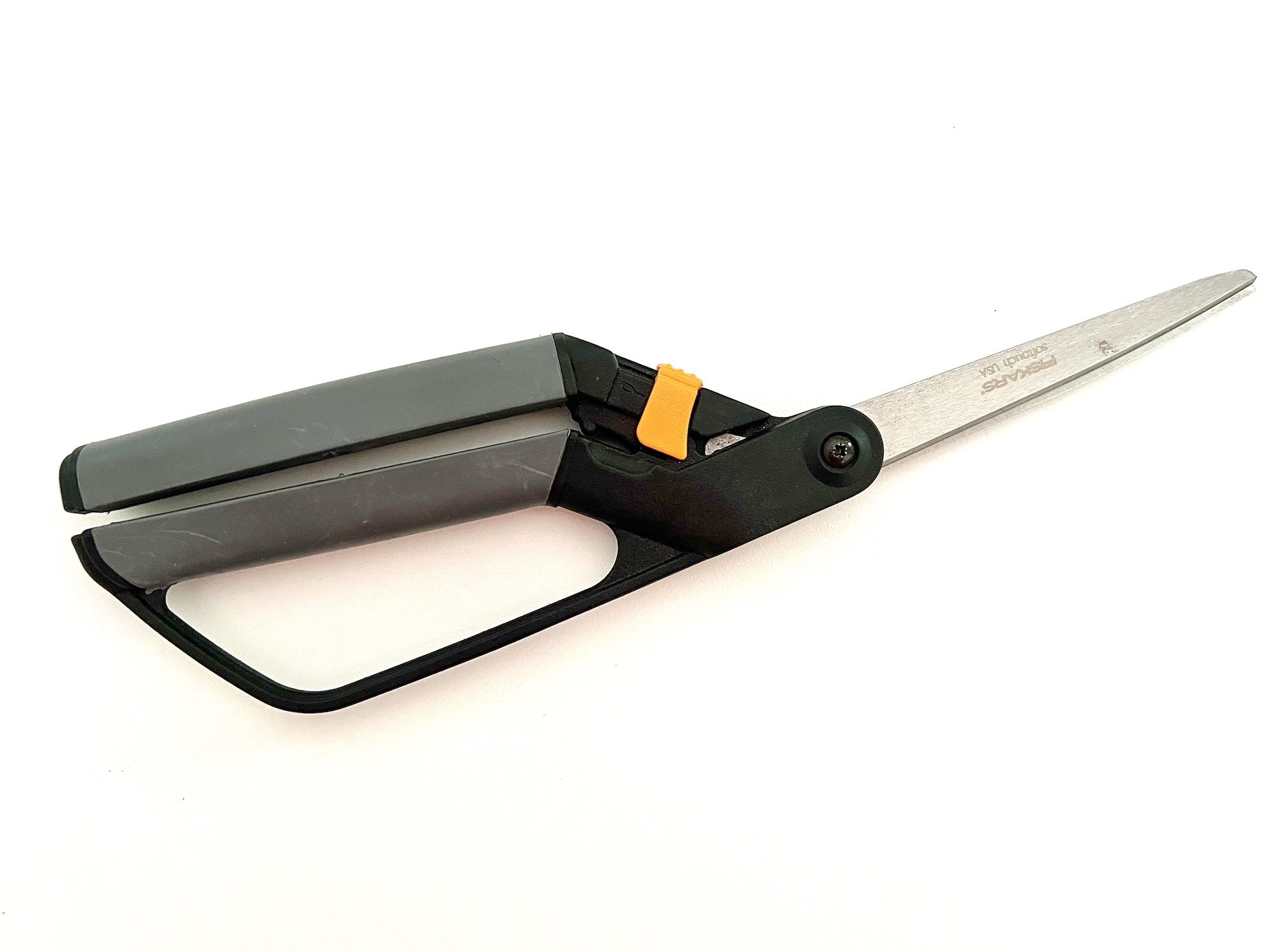
These Fiskars Easy Grip Shears are the fabric scissors I have used for two decades and definitely recommend! (Also on Michaels)
Left Handed Fabric Scissors
If you are left handed, you will be thrilled to know that there are left-handed scissors specifically made with you in mind!
Always buy a pair of scissors for your dominant hand!
General All-Purpose Scissors
While most of the scissors on our list are used to cut fabric or threads, there are still many other items you may need to cut with a sewing project such as:
- Patterns
- Packaging
- Chenille Stems with wire
Having a pair of general scissors for different purposes in your sewing kit makes sense.
I buy these 3-packs of scissors and have been really happy with their performance and price. I also like the colors they come in!
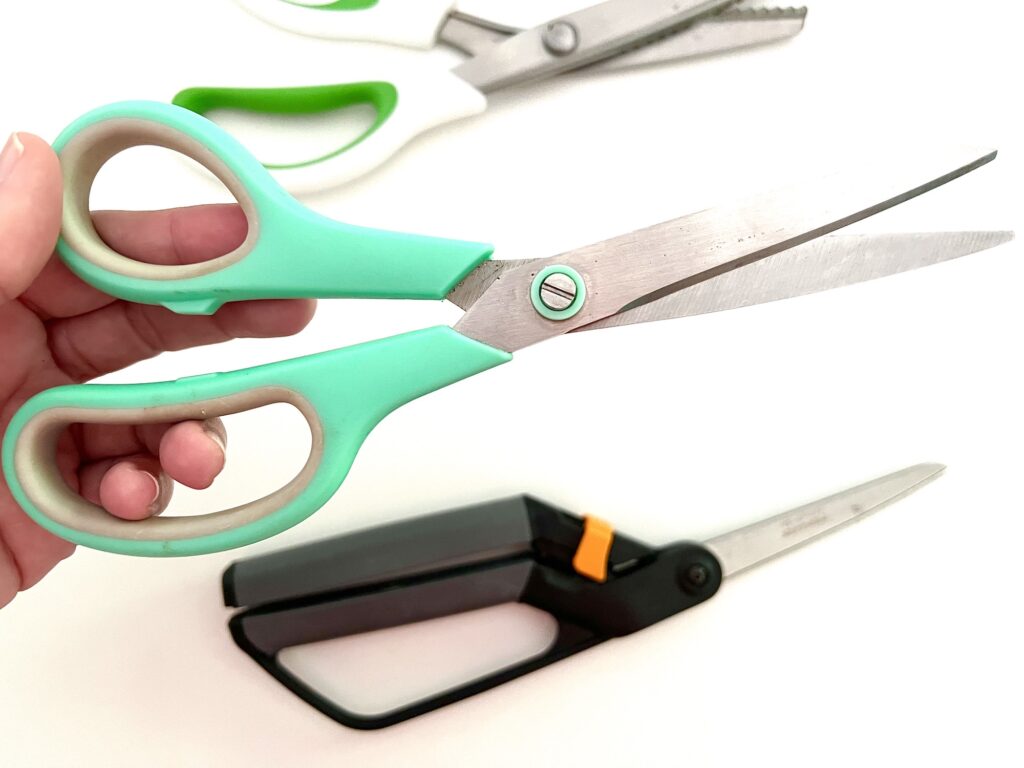
Dressmaker Shears
Very similar to fabric scissors, dressmaker shears are the heavy scissors that you usually see in old pictures and movies of people making clothing.
While fabric scissors can be smaller and more lightweight, especially with plastic handles, dressmaking shears are usually larger and have stainless steel handles, like these popular Fiskars dressmaker shears.
The handles of dressmaker shears are usually angled to allow for ergonomic cutting and to allow the bottom blade to slide easily along a flat cutting surface to cut accurately, quickly and a lot of fabric with one cut.
Pinking Shears
Pinking shears are the “zig zag” scissors that can you a decorative edge.
The small little triangles created with each cut are actually great for preventing fabric from fraying.
If you don’t have a serger, pinking shears are often used to cut seams to help finish off the edges.
I use these pinking shears and you will probably see them in a lot of my video tutorials!
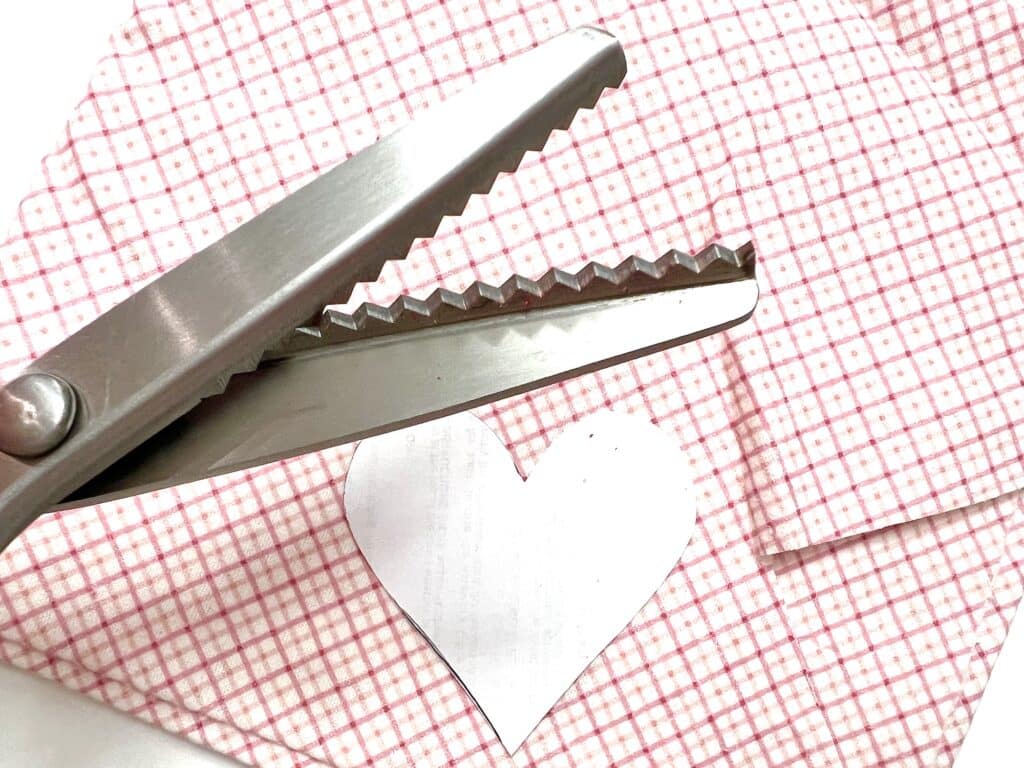
These zig-zag scissors have a serrated edge on each blade. Pinking shears are always very heavy for some weird reason, and even with the comfort grips on mine, I find myself having to take a rest after cutting large amounts of fabric with these scissors.
Rotary Cutter
Rotary cutters are pizza cutting scissors. Well, I guess they could be considered scissors because they cut fabric, but they definitely don’t look like any other scissors!
Most often used in quilting, rotary cutters are used with self healing cutting mats and acrylic rulers to quickly cut straight edges.
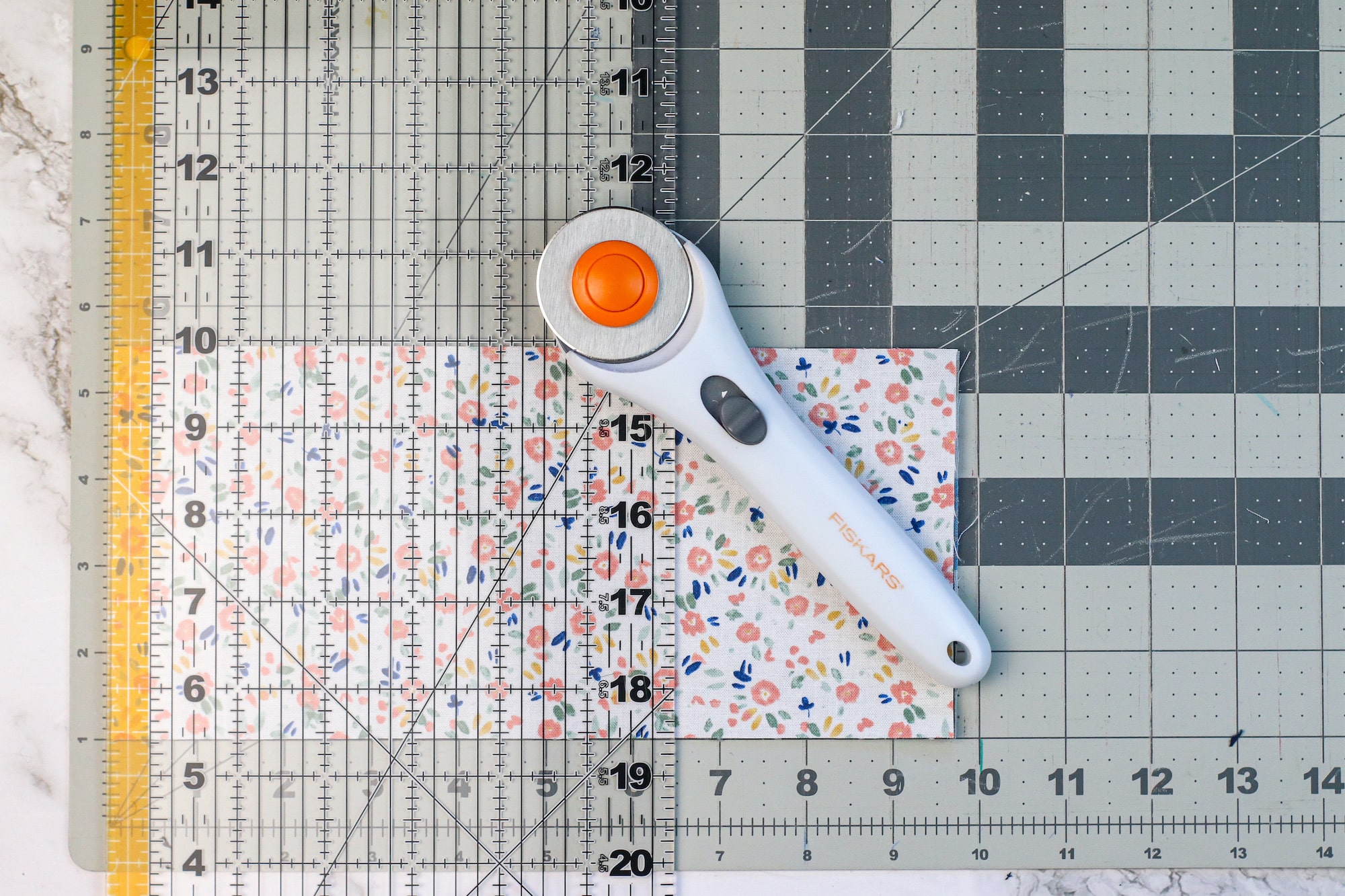
To use, place the fabric on a self healing cutting mat and roll the fabric pizza cutter along the side of the plastic ruler.
You can cut one layer of fabric or several layers of fabric at once.
Rotary cutter blades need to be extremely sharp, and they often need to be replaced. It is really important to store these scissors safely!
I’m not a big fan of using rotary scissors and I can never really get the blade to cut through the fabric in one easy motion, so I prefer fabric scissors for my sewing projects.
Thread Snips
When sewing, you will have lots of loose threads to cut. If you don’t want to pick up your heavy scissors every time you cut off extra thread, you can use thread snips.
These tiny thread snippers easily fit in your hand. Much like garden pruners, they have a spring-action design that makes the blades pop back open, reducing wrist fatigue when using them.
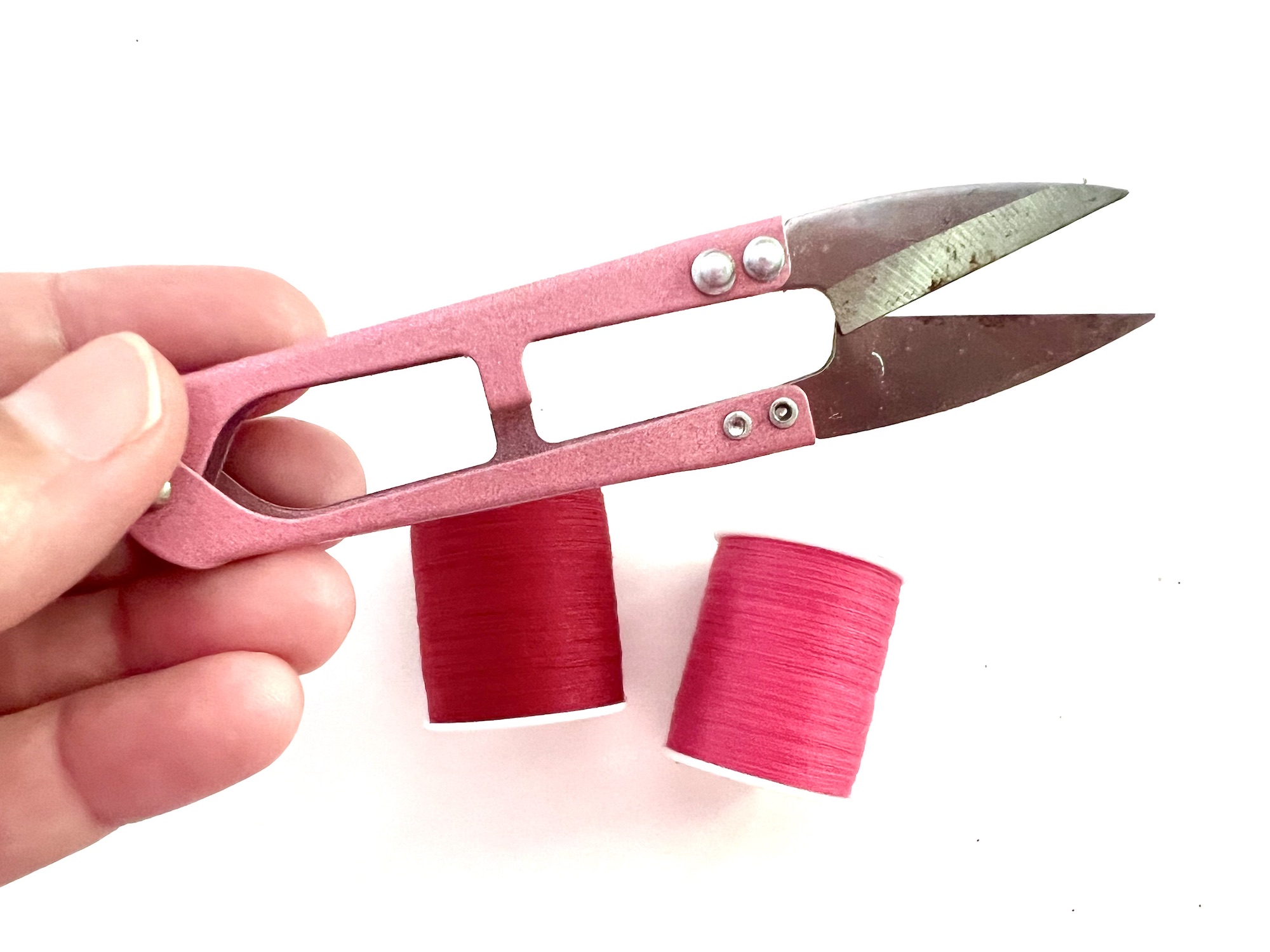
They are less cumbersome than shears and their small blades with pointed tips are ideal for quickly cutting thread.
Thread snips are also less expensive than scissors or shears, so you can keep them throughout your house.
When doing embroidery work, thread snips can be easier to use than scissors.
It is SO important to put a cover over these so that you don’t stab yourself with the sharp ends.
I personally don’t like using thread snips. I don’t find them any more convenient that using scissors, and it’s just one more thing to keep on my sewing table and try to remember where it is.
Embroidery Scissors
When you need to do fine details or precision work, you want a pair of embroidery scissors. Trust me.
I put off buying a pair of these tiny scissors for quite a while. I don’t know why, because they cost less than $10 so they are not a huge investment.
Once I got my embroidery scissors (I chose a pair that looks like a bird and makes me laugh every time I use them!), I knew why everyone makes such a fuss about getting a pair of these!

These very small scissors with a sharp tip are most often used for embroidery, appliqué work and cross stitching because they can get close to the work surface and snip off thread or embroidery floss.
If you need precise cuts in small areas, these are the scissors you need!
They are also a favorite to keep in a sewing kit or sewing bag because they are so small.
I have used these scissors for a lot of sewing projects with small details. They are one of my favorite sewing essentials!
Tailor Shears
Very similar to dressmaker shears, but meant to cut through multiple layers of fabric at a time.
The average home sewist probably doesn’t need a pair of tailor shears unless you are cutting thick fabrics or sewing a lot of clothes.
Applique Scissors
Also known as “duckbill scissors,” appliqué scissors have a curved edge with extra metal on one side that resembles the bill on a duck.
That “bill” is what protects appliqué work. You can cut very close to the stitch line without damaging the appliqué.
When using appliqué scissors, keep the bill side of the scissors on the inside of your applique piece and the flat sharp blade on the outside. You will want to hold the outside piece of the fabric UP while trimming it off.
Folding Scissors
Especially convenient for traveling, folding scissors can be folded in half to reduce their size and to protect the sharp tips.
These are great if you find yourself digging through a purse or sewing bag looking for scissors because you won’t accidentally jab yourself!
Folding scissors can be sharper than general scissors, but you wouldn’t want to cut patterns out with them regularly. They are best well-suited for snipping threads, making small cuts in fabric, etc.
Electronic Shears
If you have been to JoAnn Fabrics lately, you have probably been wowed by their electric scissors that quickly and easily slice through the fabric with straight lines.
These electric fabric scissors can be used at home, too. They are perfect for anyone with arthritis or who cannot grasp a pair of scissors easily.
Scissors vs. Shears
Yes, there is a difference between “scissors” and “shears.”
Scissors
- Shorter blades
- Equally sized finger holes
- Can be used as all purpose scissors in the household
Shears
- Longer blades
- The long blade is usually more than six inches long
- Heavier
- Finger holes in two different sizes, smaller hole for your thumb and larger hole for fingers
- Sharper than general scissors
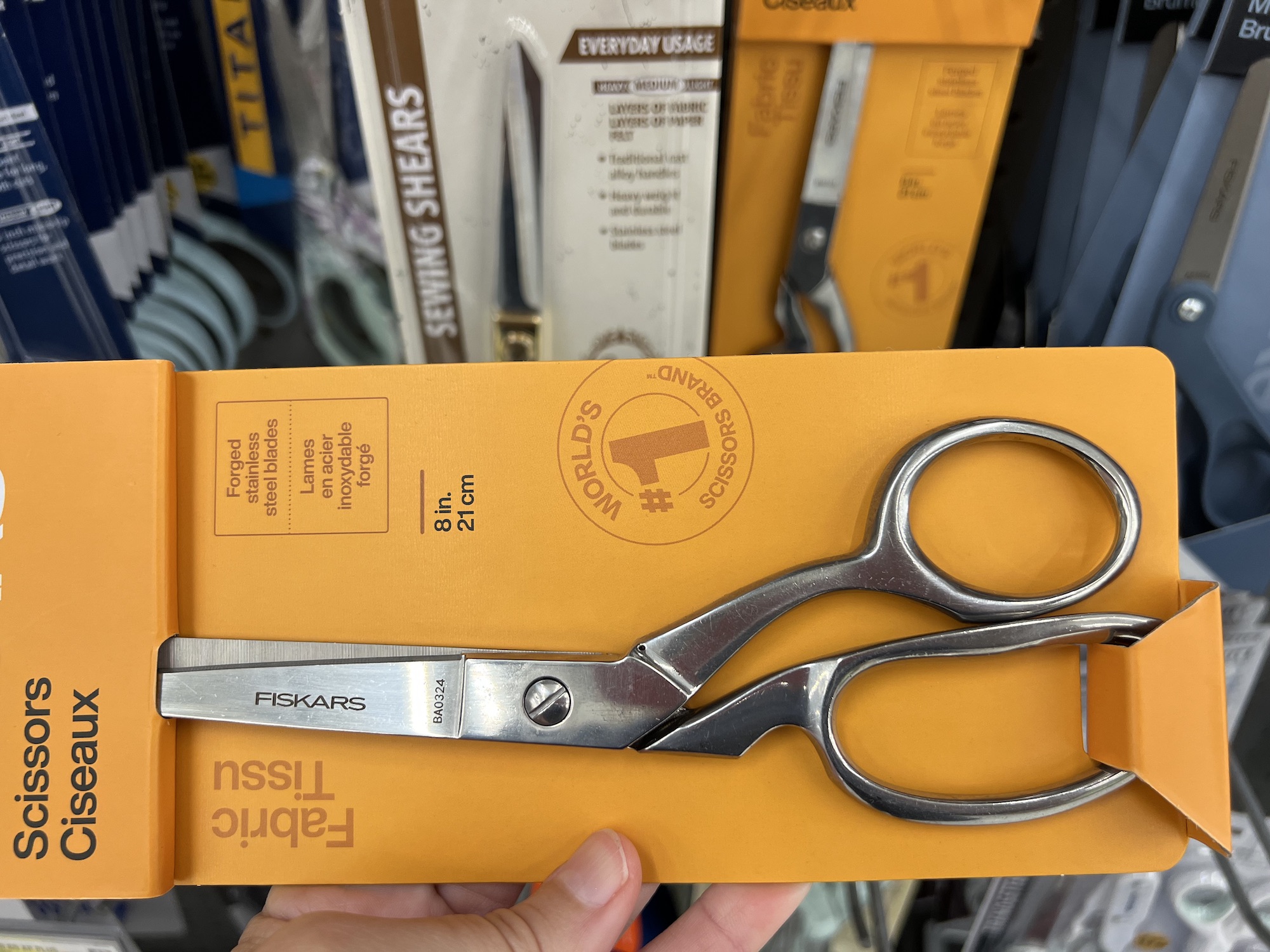
Best Sewing Scissor Brands
The best sewing scissors are the ones that fit your hand the best, have a comfortable grip and are in your budget.
However, if you are making an investment in an heirloom quality brand of scissors, these are some of the brands we use and recommend:

How to Care For Your Sewing Scissors
Always keep your scissors clean. If you cut through fabric with lots of fibers that stick to your blades, be sure to wipe off the blades promptly so that they fibers don’t get in the screw.
If you cut through something that is sticky or tacky, such as glue or adhesive, quickly wipe off the blades to remove residue.
Always keep your scissors dry. Do not store them in a damp environment.
Sharpen your scissors regularly.
If needed, use liquid bearings to oil the pivot point where the screw is. I have never had to use this oil treatments for my modern scissors, but older scissors may need the lubrication.
Oil on your scissors can RUIN your fabrics, though, so I highly suggest you use the very smallest amount possible, wipe off every last residue, and cut through scrap fabric to make sure that there is no oil left to get on your fabric.
How To Sharpen Scissors
Scissors will get dull over time, but that doesn’t mean that you have to get rid of them!
Thankfully, it is easy to sharpen sewing scissors in a variety of ways, including:
- Scissor Sharpener
- Sharpening Stone
- Knife Block with a Sharpener
- Take to a Blacksmith / Knife Sharpener
Sharpening your scissors, rather than buying a new pair, saves a lot of money if you are using a quality pair of scissors. These sharpening tools usually cost less than a new pair of scissors!
Not only is it budget friendly, but it can also save you frustration, too.
Sewists get used to the weight and feel of their scissors because they use them so often! Switching to a new pair can lead to aggravation because you need to learn the unique feel of the blades and how they cut.
The only exception is pinking shears. With all of the little triangle shaped blades, it would be a nightmare trying to sharpen them. Just buy a new pair instead.
And as we said before, rotary cutter blades are not meant to be used forever. They are designed to be replaced (which really increases the lifetime cost of using these cutters).
While you can buy tools such as a sharpening stone or scissor sharpener to use at home, you may not feel comfortable sharpening the blades.
In that case, look for knife sharpening professionals. Your local sewing or quilting shop will likely have the name of someone who provides this service. You may also want to ask at your local fabric shop, such as JoAnn Fabrics, to see if they know of someone local.
In my area, a local blacksmith also does scissor sharpening for $15 or less. That’s a great investment to take care of a pair of heirloom scissors.
Do NOT use sandpaper or aluminum foil to sharpen scissors used for sewing. Just don’t.
These “hacks” will only dull your scissors and they could mess up your scissors so that you can’t cut fabric smoothly and easily.
Save this list of best sewing scissors to Pinterest to reference later!
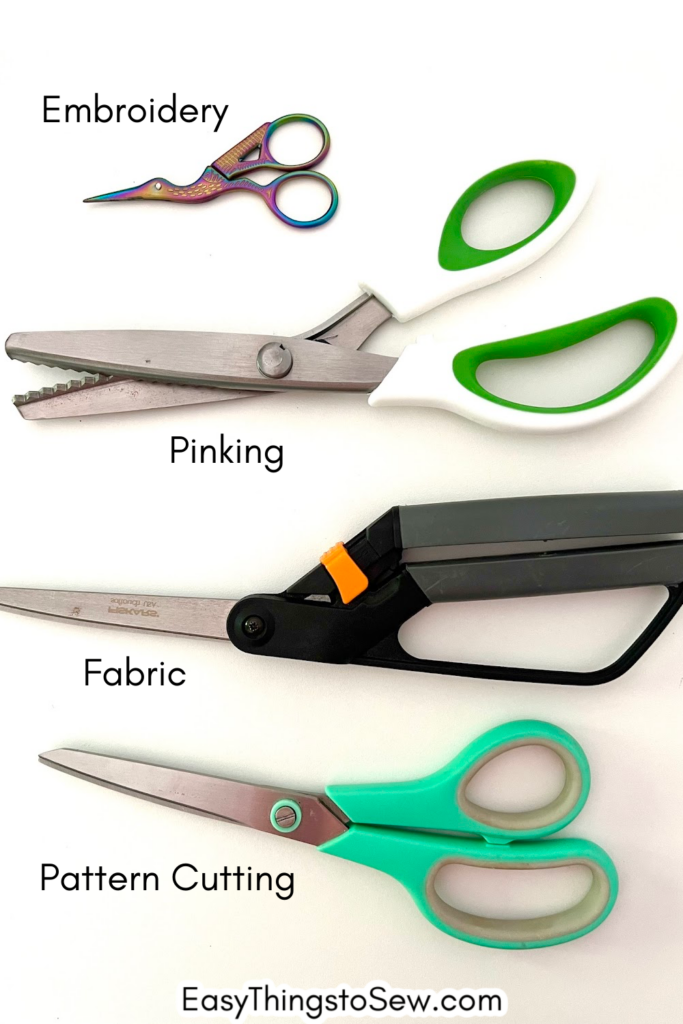
Buying the right pair of scissors is just one of the essential beginner sewing tips you need to know.
See these sewing guides next:
- What Are Sewing Notions (and Which Ones Do You Really Need?)
- Ultimate Guide to Interfacing
- How (and When) to Prewash Fabric
- Where to Find Inexpensive Fabric for Sewing Projects
- How to Sew Rick Rack

